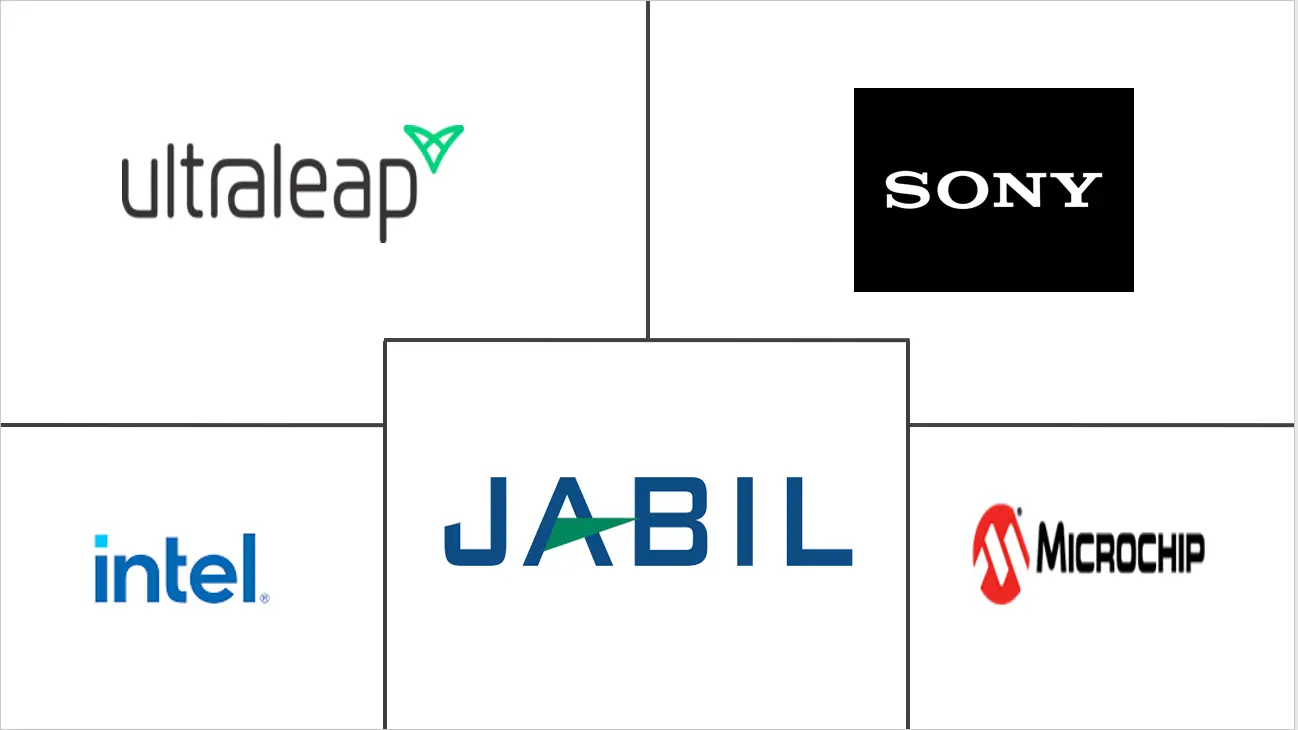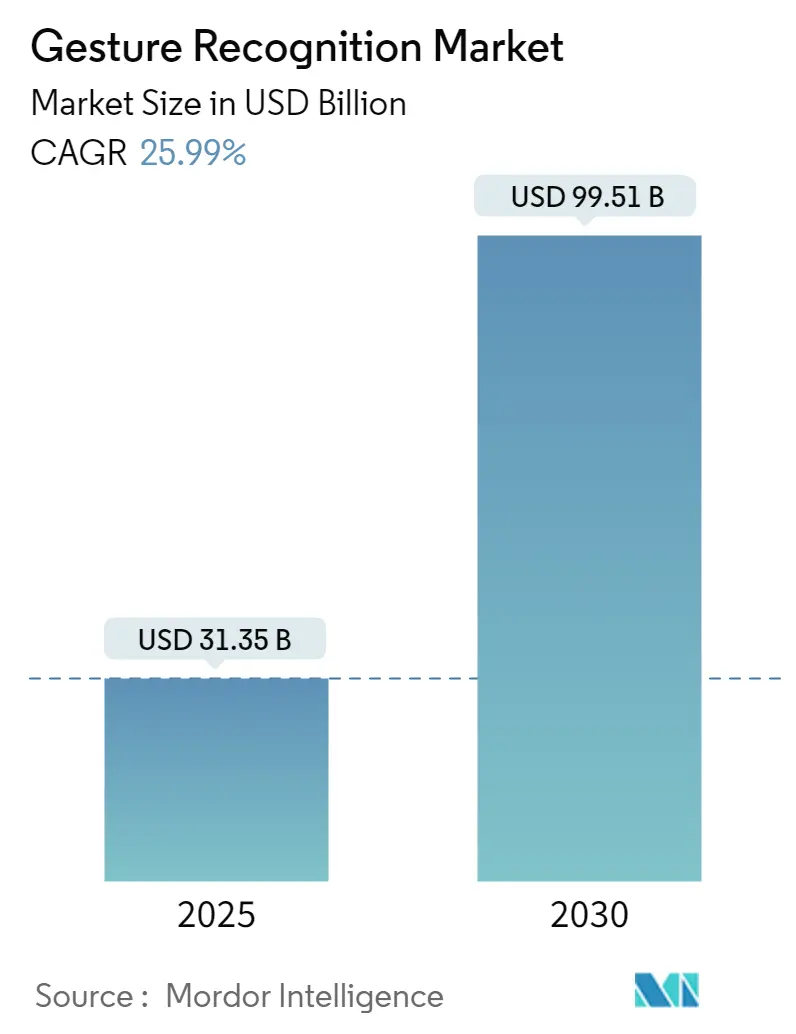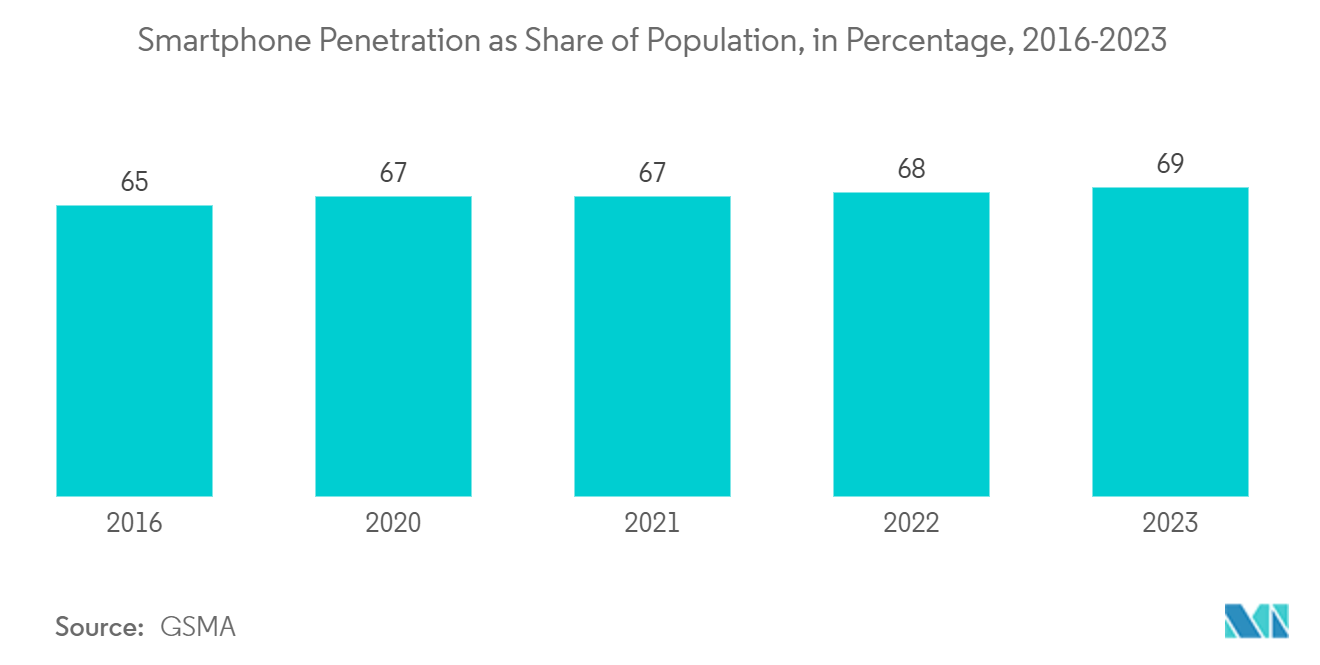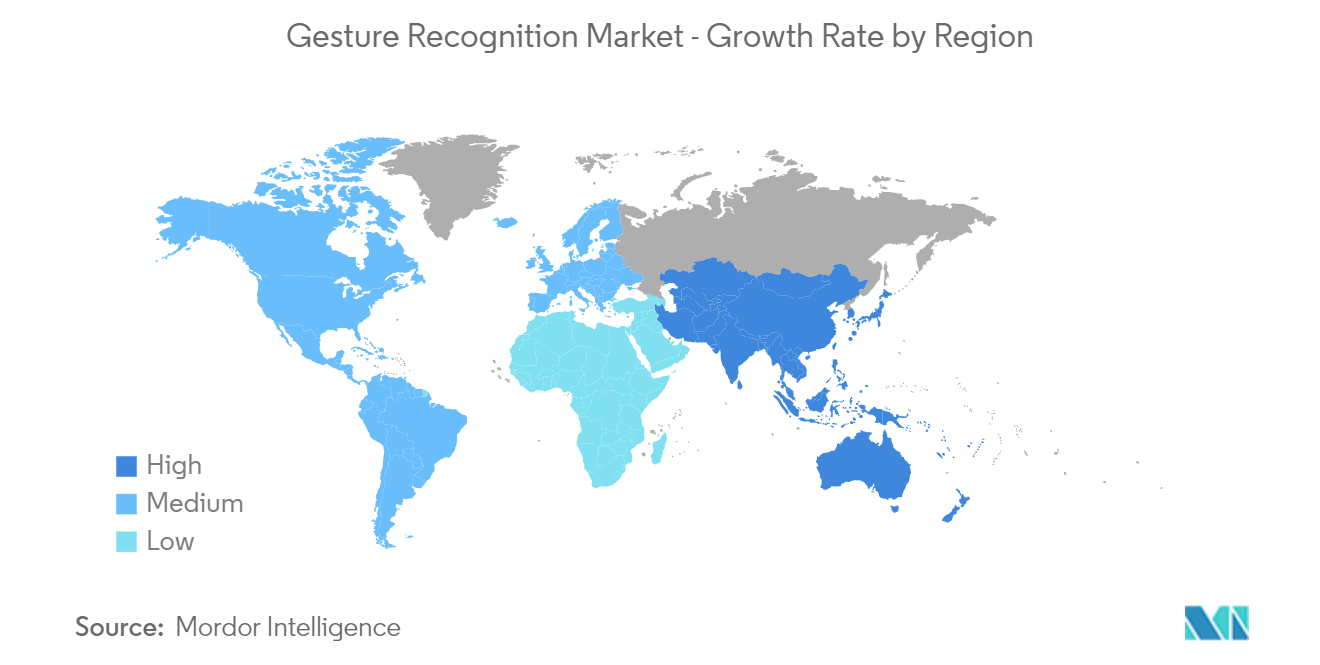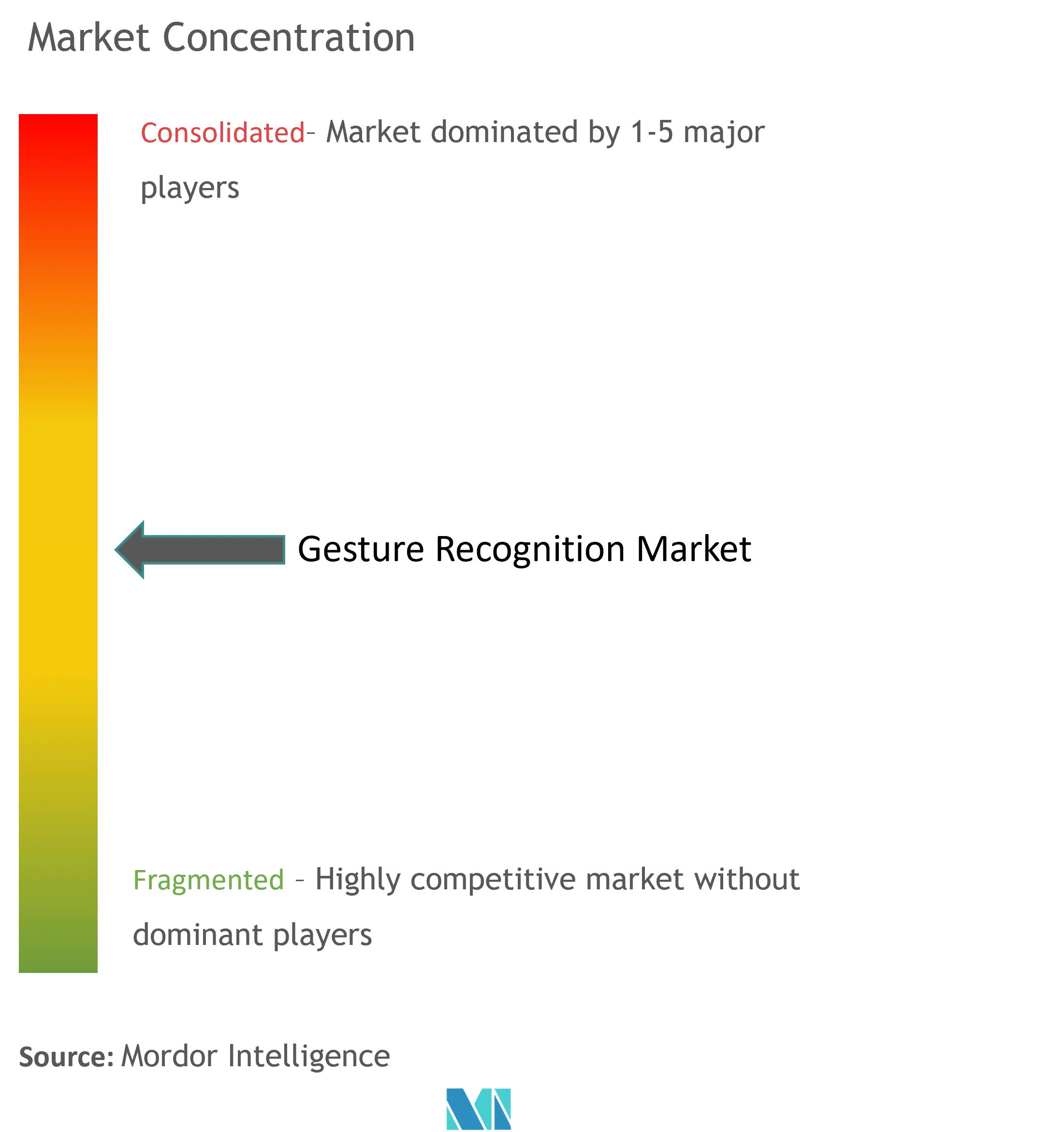Gesture Recognition Market Size
Gesture Recognition Market Analysis
The Gesture Recognition Market size is estimated at USD 31.35 billion in 2025, and is expected to reach USD 99.51 billion by 2030, at a CAGR of 25.99% during the forecast period (2025-2030).
- The development of artificial intelligence (AI) has given rise to gesture-recognition-based devices. Moreover, the recent technological advancements in the field of gesture recognition technology, coupled with increasing adoption among end-user industries, are analyzed to drive the market in the coming years.
- Gesture recognition technology is being increasingly implemented for human-device interaction due to an increased acceptance of gesture-enabled electronic devices across various industry verticals, for example, switching through television channels or radio stations. The use of gesture recognition is increasing in various sectors.
- One recent development in this area is the interaction of humans with machines by using hand gesture recognition. Another development is the use of hand gesture recognition to control computer applications.
- With continuous technological developments, the companies in the market studied have been manufacturing products incorporated with new and innovative features. Omron Corporation has developed gesture recognition technology by simultaneously recognizing the position, shape, and motion of a person's hand or finger by referencing a camera-recorded image.
- Moreover, gesture recognition technology is gaining substantial prominence among consumers and original equipment manufacturers due to increased user convenience when handling various electronic products. Manufacturers worldwide are focusing on innovation to add gesture recognition features in different consumer electronics, which has improved safety, reliability, and convenience. Further, the demand for touchless gesture recognition is governed by the increasing demand for superior user experience, ease of use, and rising digitization across several sectors.
- A gesture recognition application system comprises several key hardware and software components, all of which must be tightly integrated to provide a compelling user experience. Moreover, specialized algorithms subsequently interpret the processed data, translating the movements into actionable commands that a computer can understand. Subsequently, an application integrates these actionable commands with user feedback, which must be natural as well as engaging. Adding to the overall complexity of the solution, the algorithms and applications are increasingly being implemented on embedded systems, with limited processing, storage, and other resources.
- Additionally, the integration of advanced technologies such as artificial intelligence and machine learning in the gesture recognition ecosystem is further expanding the studied market. The proliferation of AI and ML technologies is causing paradigm shifts in Gesture recognition by offering a spectrum of feature-enriching applications in healthcare delivery, smart navigation, consumer electronics, augmented reality gaming, automation of homes, live video streaming, and virtual shopping.
Gesture Recognition Market Trends
Touch-based Gesture Recognition Segment is Expected to Hold Significant Market Share
- Touch-based gesture recognition consists of single- and multi-touch screens, which are widely used in consumer electronics. A single touch-based function can be used in many devices, such as smartphones. For instance, a single-swipe touch can be used to access the menu bar on any smartphone. The touch-based gesture recognition segment accounts for the major portion of the market, owing to the high market penetration of laptops and smartphones that have the aforementioned basic functionalities.
- Moreover, as more and more electronic consumer products such as smartphones and laptops adopt and incorporate touch-based gesture recognition, the proliferation of these consumer electronic products is expected to positively influence the growth of the market. Smartphones are expected to witness continuous growth over the next few years as companies are shifting their focus to the Asia-Pacific region, especially India, by launching low-cost and touch-based gesture recognition feature smartphones. For instance, according to the data from GSMA, the global smartphone penetration rate was estimated at 68% in 2022.
- Multi-touch-based gesture recognition is used in functions such as zoom-in, zoom-out, and three-finger screenshots in smartphones. Functions, such as desktop swap and access to the menu in Windows 10, can be found on the trackpads of laptops. Currently, the touch-based gesture recognition segment dominates the market studied due to the high market penetration of laptops and smartphones that have the aforementioned basic functionalities. The segment is expected to remain the same over the forecast period as well.
- Currently, smartphone manufacturers are launching smartphones that incorporate touch-based gesture recognition features, such as double tap to sleep and wake. In addition, laptop manufacturers are launching low-cost products that use touch-based gesture recognition, thereby augmenting the availability of the technology.
- Additionally, touch-based gesture recognition devices are the preferred choice in industrial applications. The working environment in the industry makes it mandatory for the devices to be rugged and work in extreme conditions, such as being used with gloves and greased hands, etc. Specific industry-based security and standards certifications are also necessary for the products that make the products utilized in the industry a premium solution to implement.
North America is Expected to Have a Major Share
- North America is among the market pioneers and leading innovators in terms of the adoption of gesture recognition technology. Some of the vendors, such as Jabil Inc., Leap Motion Inc., and GestureTek Inc., are headquartered in the region. The growing R&D investments in the region, as compared to the other parts of the world, are expected to further boost the market growth in terms of the adoption of the technology in the region.
- Additionally, there is an increasing demand for gesture recognition in the automotive industry in the region, owing to the increasing demand for gesture-based user interfaces in luxury cars. Growing consumer preference for advanced vehicle features and significant OEM investments in R&D would enhance product penetration.
- In terms of demand, the United States is expected to retain its presence as one of the prominent markets in consumer electronics devices, backed by diminishing replacement cycles and recovery in the spending power of key consumer groups. Consumer electronics is expected to show the maximum adoption of gesture recognition technology during the forecast period. The increase in demand for portable electronic products and wireless communications is expected to drive the market in the current region. The United States is one of the major consumers of consumer electronics in the world. The United States is also known to be a technologically advanced nation, thus becoming a target for several electronics manufacturers.
- Moreover, the region holds a prominent position in the retail industry. The adoption of gesture recognition technology is also expected to grow in the retail industry, further boosting the market growth in the region. Reasor, a grocery store chain based in Oklahoma, installed an interactive display that projects the company’s logo and message on the floor. Customers can interact with it when they walk upon it with simple gestures and body movements.
Gesture Recognition Industry Overview
The gesture recognition market exhibits a moderate level of competition, with a select few major players exerting significant influence. Currently, these industry leaders hold a dominant market share and are actively pursuing strategies to expand their reach in foreign markets. To achieve this, they are forging strategic collaborations to enhance their market presence and drive profitability.
In a recent development in June 2023, Ultraleap, a renowned provider of hand tracking and mid-air haptics technologies, made an exciting announcement. They have introduced support for their TouchFree solution on BrightSign's XC5 media players. This integration introduces a new dimension of engagement and interactivity to digital signage, offering diverse possibilities for businesses and organizations seeking innovative ways to captivate their audiences.
Gesture Recognition Market Leaders
-
Intel Corporation
-
Jabil Inc.
-
Microchip Technology Inc.
-
Sony Corporation
-
Ultraleap
- *Disclaimer: Major Players sorted in no particular order
Gesture Recognition Market News
- May 2023: Doublepoint, a Helsinki-based company specializing in touch-based micro gesture and surface interaction technology, successfully secured EUR 3 million (approximately USD 3.3 million) in a recent funding round. Superhero Capital, FOV Ventures, Superangel VC, Business Finland, and a group of angel investors led the investment. With this fresh capital infusion, Doublepoint is poised to integrate its cutting-edge gesture recognition technology into consumer electronics and various hardware solutions.
- November 2022: Hyundai Mobis Company, an automotive component manufacturer based in South Korea, introduced its innovative onboard digital display technology. This revolutionary system, known as Quick Menu Selection, employs proximity detection to respond to hand gestures. Users can effortlessly access frequently used menus by simply gesturing near the display and tapping their selection. This novel approach streamlines interaction and enhances safety during driving by reducing the need for distracting manual manipulations, thus ensuring drivers maintain focus and convenience while using in-vehicle infotainment (IVI) systems.
Gesture Recognition Industry Segmentation
Gesture recognition is the conversion of human movements or signals to commands using a mathematical algorithm. It enables people to interrelate with machines in the absence of physical devices as an input mechanism to perform desired actions in a system. The technology interprets human gestures and movements, such as the movement of hands, fingers, arms, head, or the entire body. It allows users to operate and control devices merely with their gestures.
The gesture recognition market is segmented by technology (touch-based gesture recognition, touchless gesture recognition), end-user industry (automotive, healthcare, consumer electronics, gaming, aerospace and defense, and other end-user industries), and geography (North America, Latin America, Europe, Asia-Pacific, and Middle East and Africa).
The market sizes and forecasts are provided in terms of value USD for all the above segments.
| By Technology | Touch-based Gesture Recognition | ||
| Touchless Gesture Recognition | |||
| By End-user Industry | Aerospace and Defense | ||
| Automotive | |||
| Consumer Electronics | |||
| Gaming | |||
| Healthcare | |||
| Other End-user Industries | |||
| Geography*** | North America | United States | |
| Canada | |||
| Europe | United Kingdom | ||
| Germany | |||
| France | |||
| Asia | China | ||
| Japan | |||
| India | |||
| Australia and New Zealand | |||
| Latin America | |||
| Middle East and Africa | |||
| Touch-based Gesture Recognition |
| Touchless Gesture Recognition |
| Aerospace and Defense |
| Automotive |
| Consumer Electronics |
| Gaming |
| Healthcare |
| Other End-user Industries |
| North America | United States |
| Canada | |
| Europe | United Kingdom |
| Germany | |
| France | |
| Asia | China |
| Japan | |
| India | |
| Australia and New Zealand | |
| Latin America | |
| Middle East and Africa |
Gesture Recognition Market Research FAQs
How big is the Gesture Recognition Market?
The Gesture Recognition Market size is expected to reach USD 31.35 billion in 2025 and grow at a CAGR of 25.99% to reach USD 99.51 billion by 2030.
What is the current Gesture Recognition Market size?
In 2025, the Gesture Recognition Market size is expected to reach USD 31.35 billion.
Who are the key players in Gesture Recognition Market?
Intel Corporation, Jabil Inc., Microchip Technology Inc., Sony Corporation and Ultraleap are the major companies operating in the Gesture Recognition Market.
Which is the fastest growing region in Gesture Recognition Market?
Asia Pacific is estimated to grow at the highest CAGR over the forecast period (2025-2030).
Which region has the biggest share in Gesture Recognition Market?
In 2025, the North America accounts for the largest market share in Gesture Recognition Market.
What years does this Gesture Recognition Market cover, and what was the market size in 2024?
In 2024, the Gesture Recognition Market size was estimated at USD 23.20 billion. The report covers the Gesture Recognition Market historical market size for years: 2019, 2020, 2021, 2022, 2023 and 2024. The report also forecasts the Gesture Recognition Market size for years: 2025, 2026, 2027, 2028, 2029 and 2030.
Our Best Selling Reports
Gesture Recognition Industry Report
Statistics for the 2025 Gesture Recognition market share, size and revenue growth rate, created by Mordor Intelligence™ Industry Reports. Gesture Recognition analysis includes a market forecast outlook for 2025 to 2030 and historical overview. Get a sample of this industry analysis as a free report PDF download.

